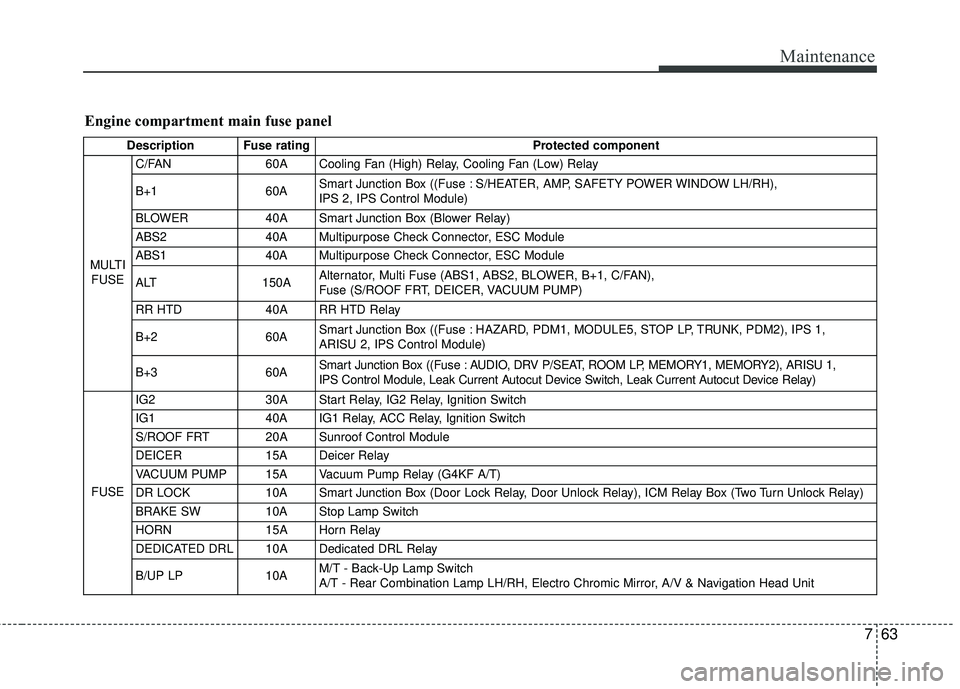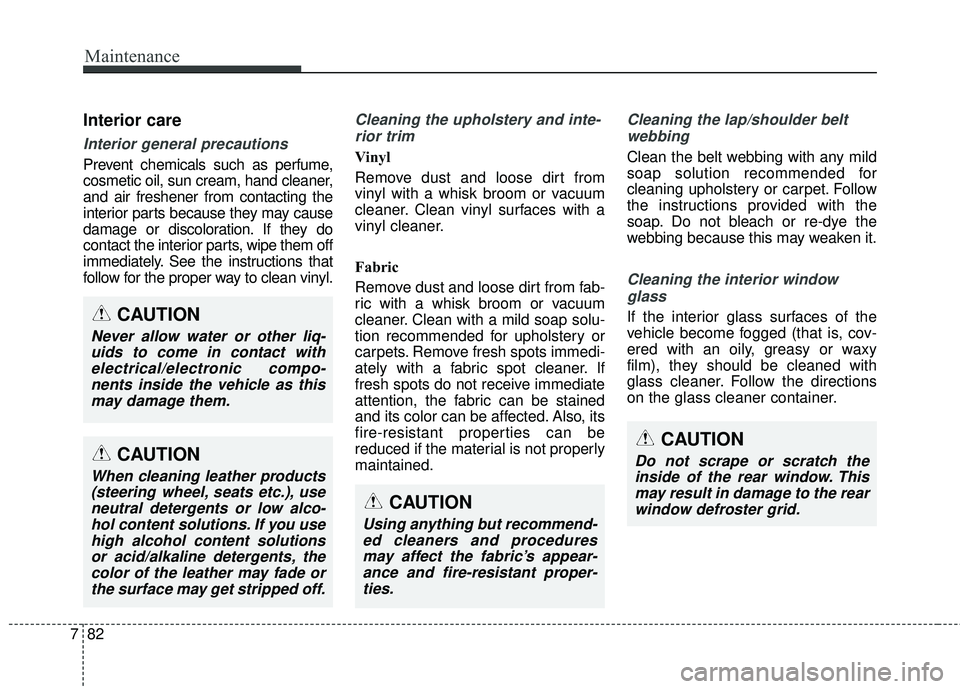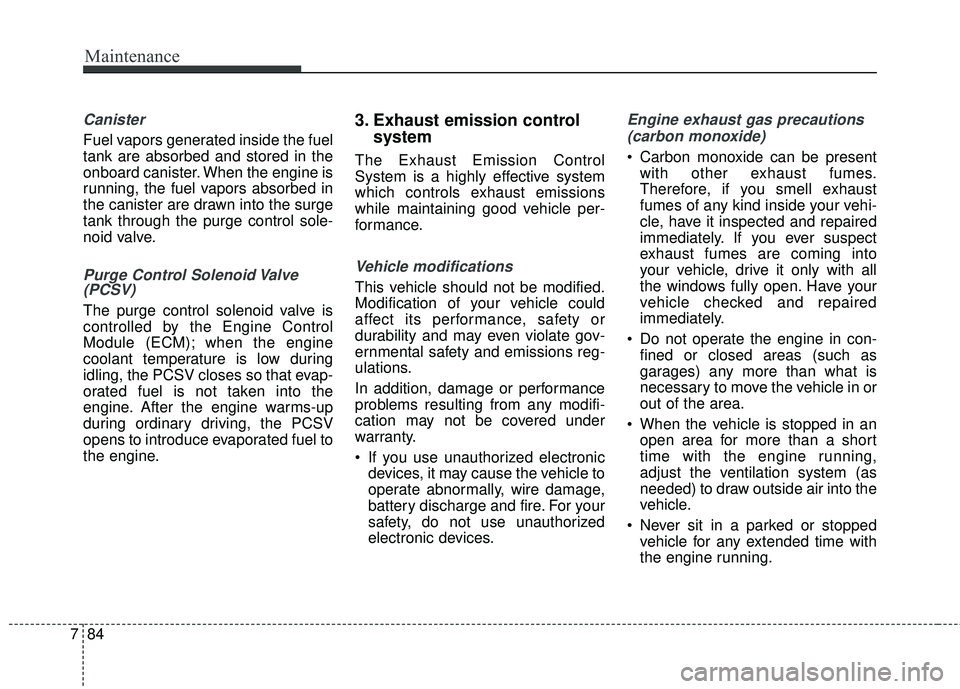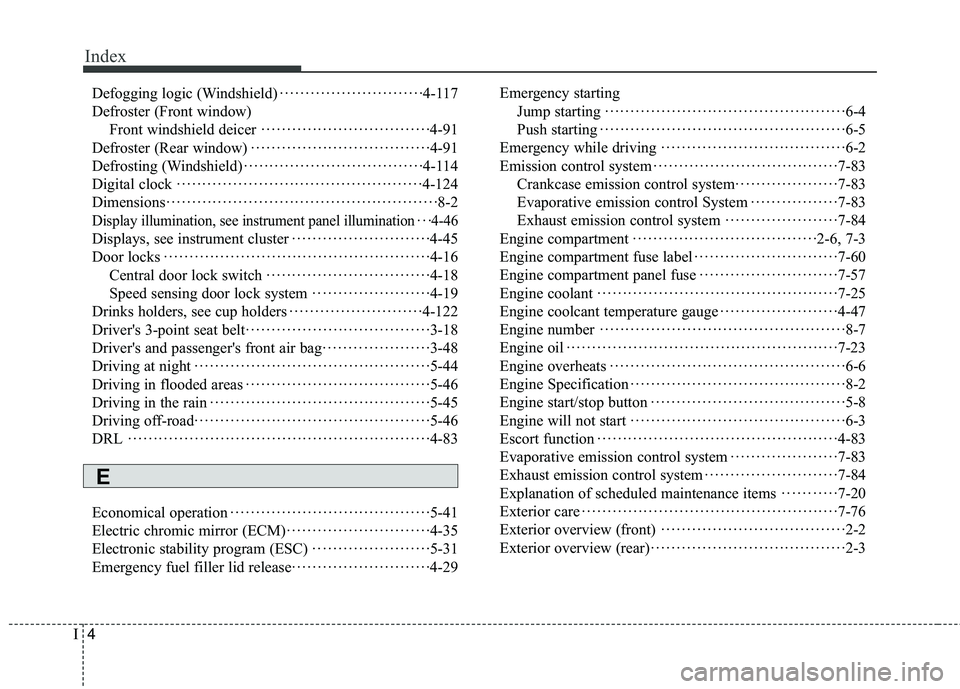2016 HYUNDAI GENESIS COUPE ULTIMATE window
[x] Cancel search: windowPage 430 of 475

761
Maintenance
Description Fuse ratingProtected component
MODULE2 7.5AIPS Control Module, Instrument Cluster (IND, MICOM), BCM, ATM Shift Lever IND.,
Multifunction Switch (Remote Control), Multi Gauge, Cruise Clutch Pedal Position Switch,
A/C Control Module, Auto Head Lamp Leveling Device Unit, Stop Lamp Switch,
Driver/Passenger Seat Warmer Module, Electro Chromic Mirror, MTS Module,
Tire Pressure Monitoring Module, Head Lamp Leveling Device Actuator LH/RH,
Front Parking Assist Sensor LH/RH
Rear Parking Assist Sensor Side LH/RH
Rear Parking Assist Sensor Center LH/RH
MODULE5 7.5A Sport Mode Switch (A/T), Key Solenoid
STOP LP 15A Stop Signal Relay
MODULE7 7.5A Blower Relay, Sunroof Control Module, A/C Control Module, Cluster Ionizer (Auto A/C)
MODULE4 7.5ABCM, PDM, IPS Control Module, Vacuum Switch
E/R Junction Box LH (Vacuum Pump Relay)
WIPER FRT 25AMultiFunction Switch (Wiper), Front Wiper Motor
E/R Junction Box LH (Wiper FRT Relay)
START 10AE/R Junction Box LH (Start Relay), Ignition Lock Switch, PDM
Transmission Range Switch, ECM (G6DJ), B/Alarm Relay
BLOWER 7.5A A/C Control Module
HTD MIRR 7.5A A/C Control Module, Driver/Passenger Power Outside Mirror
TRUNK 10A Trunk Lid & Fuel Filler Door Switch, ICM Relay Box (Trunk Lid Relay)
PDM2 10A PDM, Smart Key Control Module, Start Stop Button Switch, FOB Holder
SAFETY POWER
WINDOW RH 25A Passenger Safety Power Window Module
FOG LP RR 10A (Not Used)
S/HEATER 15A Driver/Passenger Seat Warmer Module
AMP 25A AMP (JBL)
SAFETY POWER
WINDOW LH 25A Driver Safety Power Window Module
Page 432 of 475

763
Maintenance
Engine compartment main fuse panel
Description Fuse ratingProtected component
MULTI FUSE C/FAN
60A Cooling Fan (High) Relay, Cooling Fan (Low) Relay
B+1 60ASmart Junction Box ((Fuse : S/HEATER, AMP, SAFETY POWER WINDOW LH/RH),
IPS 2, IPS Control Module)
BLOWER 40A Smart Junction Box (Blower Relay)
ABS2 40A Multipurpose Check Connector, ESC Module
ABS1 40A Multipurpose Check Connector, ESC Module
ALT 150AAlternator, Multi Fuse (ABS1, ABS2, BLOWER, B+1, C/FAN),
Fuse (S/ROOF FRT, DEICER, VACUUM PUMP)
RR HTD 40A RR HTD Relay
B+260ASmart Junction Box ((Fuse : HAZARD, PDM1, MODULE5, STOP LP, TRUNK, PDM2), IPS 1,
ARISU 2, IPS Control Module)
B+360ASmart Junction Box ((Fuse : AUDIO, DRV P/SEAT, ROOM LP, MEMORY1, MEMORY2), ARISU 1,
IPS Control Module, Leak Current Autocut Device Switch, Leak Current Autocut Device Relay)
FUSE IG2
30A Start Relay, IG2 Relay, Ignition Switch
IG140AIG1 Relay, ACC Relay, Ignition Switch
S/ROOF FRT 20A Sunroof Control Module
DEICER 15A Deicer Relay
VACUUM PUMP 15A Vacuum Pump Relay (G4KF A/T)
DR LOCK 10A Smart Junction Box (Door Lock Relay, Door Unlock Relay), ICM Relay Box (Two Turn Unlock Relay)
BRAKE SW 10A Stop Lamp Switch
HORN 15A Horn Relay
DEDICATED DRL 10A Dedicated DRL Relay
B/UP LP 10AM/T - Back-Up Lamp Switch
A/T - Rear Combination Lamp LH/RH, Electro Chromic Mirror, A/V & Navigation Head Unit
Page 435 of 475

Maintenance
66
7
LIGHT BULBS
Use only the bulbs of the specified
wattage.
✽
✽ NOTICE
After heavy, driving rain or washing,
headlight and taillight lenses could
appear frosty. This condition is
caused by the temperature difference
between the lamp inside and outside.
This is similar to the condensation on
your windows inside your vehicle
during the rain and doesn’t indicate
a problem with your vehicle. If the
water leaks into the lamp bulb cir-
cuitry, have the vehicle checked by
an authorized HYUNDAI dealer.WARNING - Working on
the lights
Prior to working on the light,
firmly apply the parking brake,
ensure that the ignition switch
is turned to the LOCK position
and turn off the lights to avoid
sudden movement of the vehi-
cle and burning your fingers or
receiving an electric shock.
CAUTION
Be sure to replace the burned- out bulb with one of the samewattage rating. Otherwise, itmay cause damage to the fuseor electric wiring system.
CAUTION
If you don’t have necessarytools, the correct bulbs and theexpertise, consult an authorizedHYUNDAI dealer. In many cases,it is difficult to replace vehiclelight bulbs because other partsof the vehicle must be removedbefore you can get to the bulb.This is especially true if youhave to remove the headlightassembly to
get to the bulb(s).
Removing/installing
the head-
light assembly can result in damage to the vehicle.
Page 445 of 475

Maintenance
76
7
Exterior care
Exterior general caution
It is very important to follow the label
directions when using any chemical
cleaner or polish. Read all warning
and caution statements that appear
on the label.
High-pressure washing
When using high-pressure wash-
ers, make sure to maintain suffi-
cient distance from the vehicle.
Insufficient clearance or excessive
pressure can lead to component
damage or water penetration.
Do not spray the camera, sensors or its surrounding area directly with
a high pressure washer. Shock
applied from high pressure water
may cause the device to not oper-
ate normally.
Do not bring the nozzle tip close to boots (rubber or plastic covers) or
connectors as they may be dam-
aged if they come into contact with
high pressure water.
Finish maintenance
Washing
To help protect your vehicle’s finish
from rust and deterioration, wash it
thoroughly and frequently at least
once a month with lukewarm or cold
water.
If you use your vehicle for off-road
driving, you should wash it after each
off-road trip. Pay special attention to
the removal of any accumulation of
salt, dirt, mud, and other foreign
materials. Make sure the drain holes
in the lower edges of the doors and
rocker panels are kept clear and
clean.
Insects, tar, tree sap, bird droppings,
industrial pollution and similar
deposits can damage your vehicle’s
finish if not removed immediately.
Even prompt washing with plain
water may not completely remove all
these deposits. A mild soap, safe for
use on painted surfaces, may be
used.
After washing, rinse the vehicle thor-
oughly with lukewarm or cold water.
Do not allow soap to dry on the fin-
ish.
APPEARANCE CARE
CAUTION
Do not use strong soap, chem- ical detergents or hot water,and do not wash the vehicle indirect sunlight or when thebody of the vehicle is warm.
Do not wash the side windows too close with high pressurewater. Water may leak throughthe windows and wet the inte-rior.
To prevent damage to the plastic parts and lamps, donot clean with chemical sol-vents or strong detergents.
WARNING - Wet brakes
After washing the vehicle, test
the brakes while driving slowly
to see if they have been affected
by water. If braking performance
is impaired, dry the brakes by
applying them lightly while
maintaining a slow forward
speed.
Page 451 of 475

Maintenance
82
7
Interior care
Interior general precautions
Prevent chemicals such as perfume,
cosmetic oil, sun cream, hand cleaner,
and air freshener from contacting the
interior parts because they may cause
damage or discoloration. If they do
contact the interior parts, wipe them off
immediately. See the instructions that
follow for the proper way to clean vinyl.
Cleaning the upholstery and inte-
rior trim
Vinyl
Remove dust and loose dirt from
vinyl with a whisk broom or vacuum
cleaner. Clean vinyl surfaces with a
vinyl cleaner.
Fabric
Remove dust and loose dirt from fab-
ric with a whisk broom or vacuum
cleaner. Clean with a mild soap solu-
tion recommended for upholstery or
carpets. Remove fresh spots immedi-
ately with a fabric spot cleaner. If
fresh spots do not receive immediate
attention, the fabric can be stained
and its color can be affected. Also, its
fire-resistant properties can be
reduced if the material is not properly
maintained.
Cleaning the lap/shoulder beltwebbing
Clean the belt webbing with any mild
soap solution recommended for
cleaning upholstery or carpet. Follow
the instructions provided with the
soap. Do not bleach or re-dye the
webbing because this may weaken it.
Cleaning the interior windowglass
If the interior glass surfaces of the
vehicle become fogged (that is, cov-
ered with an oily, greasy or waxy
film), they should be cleaned with
glass cleaner. Follow the directions
on the glass cleaner container.CAUTION
Never allow water or other liq-uids to come in contact withelectrical/electronic compo-nents inside the vehicle as thismay damage them.
CAUTION
Using anything but recommend-ed cleaners and proceduresmay affect the fabric’s appear-ance and fire-resistant proper-ties.
CAUTION
Do not scrape or scratch theinside of the rear window. Thismay result in damage to the rearwindow defroster grid.CAUTION
When cleaning leather products(steering wheel, seats etc.), useneutral detergents or low alco-hol content solutions. If you usehigh alcohol content solutionsor acid/alkaline detergents, thecolor of the leather may fade orthe surface may get stripped off.
Page 453 of 475

Maintenance
84
7
Canister
Fuel vapors generated inside the fuel
tank are absorbed and stored in the
onboard canister. When the engine is
running, the fuel vapors absorbed in
the canister are drawn into the surge
tank through the purge control sole-
noid valve.
Purge Control Solenoid Valve
(PCSV)
The purge control solenoid valve is
controlled by the Engine Control
Module (ECM); when the engine
coolant temperature is low during
idling, the PCSV closes so that evap-
orated fuel is not taken into the
engine. After the engine warms-up
during ordinary driving, the PCSV
opens to introduce evaporated fuel to
the engine.
3. Exhaust emission control
system
The Exhaust Emission Control
System is a highly effective system
which controls exhaust emissions
while maintaining good vehicle per-
formance.
Vehicle modifications
This vehicle should not be modified.
Modification of your vehicle could
affect its performance, safety or
durability and may even violate gov-
ernmental safety and emissions reg-
ulations.
In addition, damage or performance
problems resulting from any modifi-
cation may not be covered under
warranty.
If you use unauthorized electronic
devices, it may cause the vehicle to
operate abnormally, wire damage,
battery discharge and fire. For your
safety, do not use unauthorized
electronic devices.
Engine exhaust gas precautions
(carbon monoxide)
Carbon monoxide can be present with other exhaust fumes.
Therefore, if you smell exhaust
fumes of any kind inside your vehi-
cle, have it inspected and repaired
immediately. If you ever suspect
exhaust fumes are coming into
your vehicle, drive it only with all
the windows fully open. Have your
vehicle checked and repaired
immediately.
Do not operate the engine in con- fined or closed areas (such as
garages) any more than what is
necessary to move the vehicle in or
out of the area.
When the vehicle is stopped in an open area for more than a short
time with the engine running,
adjust the ventilation system (as
needed) to draw outside air into the
vehicle.
Never sit in a parked or stopped vehicle for any extended time with
the engine running.
Page 468 of 475

Index
4I
Defogging logic (Windshield)··················\
··········4-117
Defroster (Front window) Front windshield deicer ··················\
···············4-91
Defroster (Rear window) ··················\
················ ·4-91
Defrosting (Windshield) ··················\
·················4-114
Digital clock ··················\
··················\
··········· ·4-124
Dimensions ··················\
··················\
·················8-2
Display illumination, see instrument panel illumination · · ·4-46
Displays, see instrument cluster ··················\
·········4-45
Door locks ··················\
··················\
··············· ·4-16
Central door lock switch ··················\
··············4-18
Speed sensing door lock system ··················\
·····4-19
Drinks holders, see cup holders ··················\
········4-122
Driver's 3-point seat belt ··················\
················· ·3-18
Driver's and passenger's front air bag ··················\
···3-48
Driving at night ··················\
··················\
········· ·5-44
Driving in flooded areas ··················\
················· ·5-46
Driving in the rain ··················\
··················\
······ ·5-45
Driving off-road ··················\
··················\
········· ·5-46
DRL ··················\
··················\
··················\
···· ·4-83
Economical operation ··················\
··················\
·· ·5-41
Electric chromic mirror (ECM) ··················\
··········4-35
Electronic stability program (ESC) ··················\
·····5-31
Emergency fuel filler lid release ··················\
·········4-29 Emergency starting
Jump starting ··················\
··················\
·········· ·6-4
Push starting ··················\
··················\
··········· ·6-5
Emergency while driving ··················\
················· ·6-2
Emission control system ··················\
················· ·7-83
Crankcase emission control system ··················\
··7-83
Evaporative emission control System ·················7-83
Exhaust emission control system ··················\
····7-84
Engine compartment ··················\
················· ·2-6, 7-3
Engine compartment fuse label ··················\
··········7-60
Engine compartment panel fuse ··················\
·········7-57
Engine coolant ··················\
··················\
·········· ·7-25
Engine coolcant temperature gauge ··················\
·····4-47
Engine number ··················\
··················\
··········· ·8-7
Engine oil ··················\
··················\
·················7-23
Engine overheats ··················\
··················\
········· ·6-6
Engine Specification ··················\
··················\
····· ·8-2
Engine start/stop button ··················\
··················\
· ·5-8
Engine will not start ··················\
··················\
····· ·6-3
Escort function ··················\
··················\
·········· ·4-83
Evaporative emission control system ··················\
···7-83
Exhaust emission control system ··················\
········7-84
Explanation of scheduled maintenance items ···········7-20
Exterior care ··················\
··················\
··············7-76
Exterior overview (front) ··················\
················· ·2-2
Exterior overview (rear) ··················\
··················\
· ·2-3
E
Page 475 of 475

I11
Index
Vanity mirror lamp··················\
··················\
····· ·4-90
Vehicle break-in process ··················\
··················\
·1-5
Vehicle capacity weight ··················\
··················\
·5-52
Vehicle certification label ··················\
··················\
8-6
Vehicle curb weight ··················\
··················\
···· ·5-57
Vehicle data collection and event data recorders ·········1-7
Vehicle identification number (VIN) ··················\
·····8-6
Vehicle load limit ··················\
··················\
······· ·5-52
Cargo capacity ··················\
··················\
······· ·5-53
Certification label ··················\
··················\
··· ·5-55
Seating capacity ··················\
··················\
····· ·5-52
Steps For Determining Correct Load Limit ··········5-53
Tire and loading information label ··················\
···5-52
Towing capacity ··················\
··················\
····· ·5-53
Vehicle capacity weight ··················\
···············5-52
Vehicle weight ··················\
··················\
·········· ·5-57
Base curb weight ··················\
··················\
···· ·5-57
Cargo weight ··················\
··················\
········· ·5-57
GAW (Gross axle weight) ··················\
·············5-57
GAWR (Gross axle weight rating) ··················\
···5-57
GVW (Gross vehicle weight) ··················\
·········5-57
GVWR (Gross vehicle weight rating) ·················5-57
Vehicle curb weight ··················\
··················\
· ·5-57
VIN number ··················\
··················\
················8-6
Volume/weight ··················\
··················\
·············8-3 Walk in device
··················\
··················\
·········· ·3-12
Warning and indicators ··················\
··················\
·4-62
Washer fluid ··················\
··················\
··············7-30
Weight/volume ··················\
··················\
············ ·8-3
Welcome function ··················\
··················\
······ ·4-84
Wheel alignment and tire balance ··················\
·······7-44
Wheel replacement ··················\
··················\
····· ·7-46
Windows ··················\
··················\
················· ·4-22
Auto up/down window ··················\
··············· ·4-23
Windshield defrosting and defogging ··················\
·4-115
Defogging logic ··················\
··················\
···· ·4-118
W
inter driving ··················\
··················\
··········· ·5-48
Snow tires ··················\
··················\
············ ·5-48
Tire chains ··················\
··················\
············ ·5-49
Wiper blades ··················\
··················\
··············7-35
Wipers and washers ··················\
··················\
···· ·4-87
VW